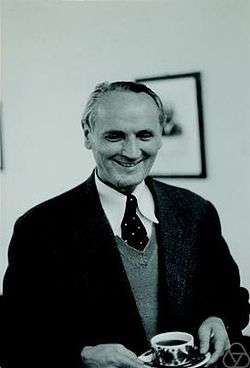Đuro Kurepa
| Đuro Kurepa | |
|---|---|
|
Đuro Kurepa | |
| Born |
August 16, 1907 Majske Poljane, Austria-Hungary |
| Died |
November 2, 1993 (aged 86) Belgrade, Serbia |
| Residence | Belgrade, Socialist Federal Republic of Yugoslavia |
| Fields | Mathematics |
| Institutions |
University of Zagreb University of Belgrade |
| Alma mater |
University of Zagreb University of Paris |
| Doctoral advisor | Maurice René Fréchet |
| Doctoral students | |
| Known for | Set theory and logic |
| Notable awards | AVNOJ Award[1] |
Đuro Kurepa (pronounced [dʑǔːrɔ kǔrɛpa]; Serbian Cyrillic: Ђуро Курепа, English transliteration: Djuro Kurepa, French: Georges Kurepa, August 16, 1907 – November 2, 1993) was a Yugoslav mathematician.[1] Throughout his life, Kurepa published over 700 articles, books, papers, and reviews[2] and over 1,000 scientific reviews. He lectured at universities across Europe, as well as those in Canada, Cuba, Iraq, Israel, and the United States, and was quoted saying "I lectured at almost each of [the] nineteen universities of [the former] Yugoslavia..."[1] His nephew was the noted mathematician Svetozar Kurepa.[3]
Early life
Born in Majske Poljane, Kingdom of Croatia-Slavonia, Austria-Hungary, Kurepa was the youngest of Rade and Andelija Kurepa's fourteen children. He began his schooling in Majske Poljane, continued his education in Glina, and graduated from high school in Križevci.[2] He received a diploma in theoretical mathematics and physics from the University of Zagreb in 1931, and began work as an assistant in the teaching of mathematics the same year. Kurepa then went to the Collège de France and the University of Paris, where he received his doctoral diploma in 1935; his advisor was French mathematician Maurice René Fréchet, and his thesis was titled Ensembles ordonnés et ramifiés.[2]
Middle years
Kurepa continued to receive post-doctoral education at Warsaw University in Poland and the University of Paris. He became an assistant professor at the University of Zagreb in 1937, associate professor the next year, and assumed the position of full professor in 1948.[1] After the end of World War II and the formation of the Socialist Federal Republic of Yugoslavia, he traveled to five universities in the United States: Harvard University in Cambridge, Massachusetts, the University of Chicago in Chicago, Illinois, the branch of the University of California at Berkeley and the branch at Los Angeles, California the Institute for Advanced Study in Princeton, New Jersey[2] and Columbia University in New York City, New York.[1]
Kurepa was ICM Plenary Speaker in 1954 and 1958.[4]
Later life
In 1965, Kurepa shifted to the University of Belgrade, where he focused on the fields of logic and set theory mathematics. Kurepa was a member of several organizations, including the Serbian Academy of Sciences and Arts and the Yugoslav Academy of Sciences and Arts (renamed the Croatian Academy of Sciences and Arts in 1991)[5] He was also the founder and president of the Society of Mathematicians and Physicists of Croatia, the founder and chief editor of the journal Mathematica Balkanica, and the president of the Yugoslav National Committee for Mathematics, the Balkan Mathematical Society, and the Union of Yugoslav Societies of Mathematicians, Physicisists and Astronomers. He received the AVNOJ Award in 1976, and retired from the University of Belgrade in 1977.[1]
He died tragically after being beaten by thugs and hidden from view under stairs.[6]
Legacy
Kurepa influenced set theory mathematics in several ways, including lending his name to the Kurepa tree. According to Kajetan Šeper, Kurepa's colleague from the University of Zagreb:
Professor Kurepa was not only the professional mathematician and teacher, but he was a scientist, philosopher, and humanist as well, in the true sense of these words. He was the founder and pioneer in mathematical logic and the foundations of mathematics in Croatia, and modern mathematical theories in Croatia and Yugoslavia. Generally speaking, he was the catalyzer, the initiator, and the bearer of mathematical science.
According to the Mathematics Genealogy Project, Kurepa supervised 26 students, among which are set theorist Stevo Todorčević, and Ljubisa D.R. Kocinac, who greatly influenced the development of selection principles.
Publications
- Kurepa, G. (1935), "Ensembles ordonnés et ramifiés", Publ. math. Univ. Belgrade, 4: 1–138
References
- 1 2 3 4 5 6 Mijajlović, Žarko (1995). "Đuro Kurepa" (PDF). 57: 13–18. Retrieved 2007-01-01.
- 1 2 3 4 O'Connor, John J.; Robertson, Edmund F., "Đuro Kurepa", MacTutor History of Mathematics archive, University of St Andrews.
- ↑ http://dnevnik.hr/vijesti/znanost-it/umro-istaknuti-matematicar-svetozar-kurepa.html
- ↑ ICM Plenary and Invited Speakers since 1897
- ↑ "The Founding of the Academy". Croatian Academy of Sciences and Arts. 2004-12-23. Archived from the original on 2006-09-28. Retrieved 2007-01-01.
- ↑ Sets and Extensions in the Twentieth Century by Dov M. Gabbay, Akihiro Kanamori (eds.), and John Woods, Elsevier, 2012 p. 186
External links
- Đuro Kurepa at the Mathematics Genealogy Project (thesis in Paris)
- Đuro Kurepa at the Mathematics Genealogy Project (thesis in Belgrade)
- (in Serbian) Biography of Kurepa
- Dimitrić, Radoslav. Academician, Professor Ðuro Kurepa (1907--1993). The Review of Modern Logic 1994. 4:401-403
